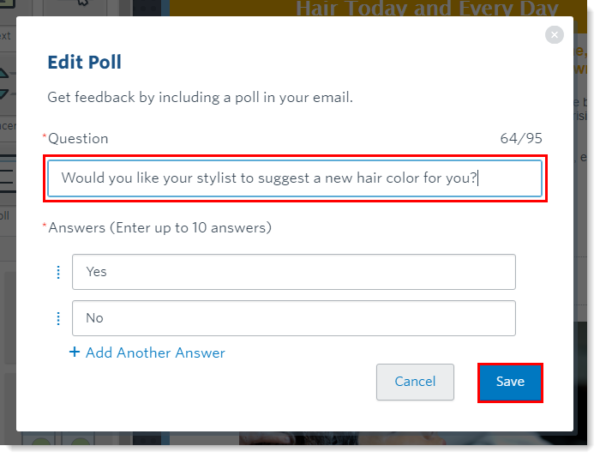“Time is money” is true. The hours in the day that your team can devote to doing the work of delivering your mission should be valued as your most precious commodity. Everything you do during the workday comes at the expense of doing something else, and successful organizations align the time and the effort they spend on the things that generate the greatest return on their time.
As a nonprofit, you can maximize your efficiency by using tech tools that produce actionable data to guide decisions about where you should be spending your time.
3 Ways Data Can Help Your Nonprofit Make Better Decisions
By analyzing your actions and results, your organization can see where the best bang-for-the-buck comes in and know which campaigns, constituents, and operational tasks deserve the bulk of your time and effort at any given moment. Here are 3 benefits of applying data to your organizational decisions today:
1. Optimize Internal Processes
Automated workflows and integrated systems make just about everything easier. When you have fewer steps needed to transfer data between systems, and you spend less time on repetitive tasks, you have more time to focus on your mission and your operations. For example, if you have a connection between your online donation forms and your donor management CRM system, your online gifts can be processed and imported directly into your donor database.
With automated software solutions, you take things a step further by sending personalized, dynamic thank you emails, or alerts to your team when a larger-than-normal donation comes through. By allowing data to flow between your systems, you effortlessly empower yourself and your team to work more efficiently. Top priorities can be defined by the data that supports them, not guesses or whims. Best of all, your time can be reserved for those priorities because smaller tasks will be handled for you.
Still not using email to market your business? Give Constant Contact a try for FREE!
2. Better Engage with Constituents
Technology can offer you a comprehensive picture of your constituents based on all of your interactions with them, both individually and collectively. This “360-degree view” of your constituents is what can help you play just the right card at just the right time.
Start by aggregating all of the data you have about your supporters, members, volunteers, donors, and prospects into a single system. Then add even more data from third party sources, like data research services, social platforms, direct mail providers, and more. This type of data makes your job easier because you will be able to learn what attributes your supporters have in common, who they are as people, and what types of messaging motivates them to support your mission.
Use a template-based website builder, an email marketing platform like Constant Contact, and social media platforms to share your stories, your work, your impact, and your team working to make a difference.
Tip: Short on staff and budget? Contact local colleges and post on social media looking for volunteer art students who need portfolio examples. Trained designers can help your organization look like a million bucks with a clever photo filter or a new layout for your website.
3. Simplify Financial Operations
Software products like Microsoft Excel, Google Sheets, or QuickBooks offer financial statement and budgeting templates that are built to help you visualize and report your cash flow projections to your board and donors. These polished spreadsheets can make a big difference when:
- Comparing budgeted numbers to the actual results so you can forecast accurately for the future
- Forecasting a 24 to 36 month estimate for operating expenses and revenue
- Projecting growth of new initiatives and new revenue sources
Managing merchant account statements and fees from multiple providers can be confusing and difficult. To gain maximum efficiency, you want to work with a single provider that can accommodate all of the ways you receive payments: checks in the mail, online donations on your website, tickets to events, merchandise in your shop, or services delivered by your organization.
Your merchant services provider and technology integrations can help you simplify how your funds are being processed. The more automation you can build into your donation processing workflow with solutions like check scanning, automatic monthly giving, and mobile card scanning, the easier and faster it will be to record, manage, and allocate your funds to the aspects of your program that need them the most.
Let your data guide you
By using tech tools and data to help optimize your processes, you will be able to spend your time where it is needed most. We live in a time where information and technology are at our fingertips. Take advantage of the technology and data available to your nonprofit, and build out your plan for success today.
Still not using email to market your business? Give Constant Contact a try for FREE!
Numbers, figures, and data may not be the most exciting and creative bit of marketing; but that’s what helps us know if our plans are working.
Email marketing is one of the most effective ways to reach out to customers, potential customers and leads. It is a direct way to get information about your business into their personal space: their inbox.
But to really know if the email being sent out is driving action or at least getting noticed, you need to analyze your email marketing metrics. Let’s start with the metric we call “open rate”.
Email open rate: What is it? How do I measure it? What is a good open rate for email? How can I increase email open rate?
Have you found yourself asking these questions? Don’t worry, you’re not alone.
Let’s start from the ground up.
Not a Constant Contact customer? Start your free 60-day trial today!
What is an email open rate?
Open rate for email marketing shows us the number of email recipients who opened the email. This is analyzed in percentages.
For example, if your email open rate shows 60% that means if you sent emails to 100 subscribers, 60 of them were opened. The other 40 emails remained unopened.
Yes, it’s that simple and direct. Email open rate is the measurement of how many of your emails were opened. The effectiveness of the email from there on and whether it compelled people to take further action, is measured with different metrics such as email click-through rate and conversion rate.
Once you master email measurement you can get a lot more from it and drive more business.
What aspects affect an email open rate?
Now that we know what an email open rate is, it is also important to know what different aspects affect an email open rate. Taking a close look at these variables can help you interpret your email campaign results and gain insight into how you stack up against the industry average email open rate, easily and effectively.
Open rate can be influenced by the following parameters:
1. Subject lines
The email subject line is one of the very first things that your recipients see. If the subject line is too weak, vague or irrelevant chances are your email will not be opened by your subscribers.
2. Sender information
Who is sending the email and how easily the recipient recognizes the sender information is another aspect that impacts email open rate. Are emails coming from your CEO’s name and email address or your brand’s name? Testing the sender information on your email marketing campaigns is a great way to see what name your email subscribers resonate with most.
3. Bad timing
Maybe all is perfect but the only thing bringing down your email open rate is bad timing. You may be sending out your emails at the wrong time and this can have an adverse effect on the open rate of your marketing emails. Find the best time to send emails before you send.
4. Segmentation
If you are not segmenting your subscriber list, you will end up sending irrelevant marketing emails to people who may soon stop opening your emails altogether. Segmenting your email list and using tags helps to be more relevant and thus more valuable to your email recipients.
What is a good open rate for email?
This is one of the most frequently asked questions by email marketers, business owners, and entrepreneurs alike.
The simple answer to this is that anything between a 15-25 % is a good email open rate.
However, it’s not that straightforward.
To truly analyze an email open rate and see what really works with your customers, it’s always best to differentiate between open rates on mobile devices, desktop and tablets.
Additionally, every industry in itself has different email marketing benchmarks, and knowing these average industry rates for email is a good place to start.
As reported by Smart Insights, the average open rate across all the industries was 24.7% in 2017.
If you have been wondering how to make your emails more effective or are confused why your emails aren’t driving the results you expected, the best thing to do is start using email tracking software to get all the data you need to make your email campaigns stronger and more effective.
How will email tracking software help? It will enable you to:
- Pull in-depth engagement reports to access open rates, click-through rates, bounce rates, and more.
- Compare different email campaigns to see what works best
- Segment contacts to increase relevancy and better results
- Access reports, data and all supporting email marketing metrics in one place
- Integrate directly into your Constant Contact account
Good email open rates come with consistent effort
The truth about email open rates is that they get better over time with consistency and just the right amount of hard work.
Consider email marketing as a recipe for your favorite dish. Every ingredient you add has its own flavor and adds to the overall taste.
When looking at the many metrics to analyze the effectiveness of email marketing, all metrics are equally important and deserve equal attention.
It doesn’t matter which email performance metric works best for your business, but only how many people you can get to take the desired action.
But hey, can you make a Pizza without a base?
Email open rates are the very base to your email marketing campaign because no matter how compelling and attractive the offers and information within your emails are, it’s of no use if your customers aren’t even opening them.
That said, give it time. Rome wasn’t built in a day!
You can’t expect a 100% email open rate with the very first campaign or even within the first few ones.
Consistency, persistence, creativity, testing, analyzing, segmenting- these are the ingredients that slowly mix together to create a dish that is not just delicious but an absolute hit amongst your customers.
How to increase email open rate
That brings us to our final question- how does one go ahead and grow from here?
When understanding how to increase your email open rate, you first need to understand and analyze the existing email metrics and data you have in order to know where you are and where you want to go. Here’s how:
First, clean up your subscriber list.
Is your list updated? Are those emails still valid? Are the people on your contact list potential customers? Current customers?
Cleaning up your contact list through a simple re-engagement campaign will not just let you know who your real customers are, but also save you from being ‘junked’ and sent to the spam folder over time.
Send a confirmation email, something like,
‘Hey! We noticed you have not been opening our emails. Would you like to continue receiving our newsletter/promotions?’
This will give your customers a chance to walk out or take notice and hurry back in. And, this gives you a chance to increase your email open rate and have only the really interested, quality contacts on your list.
Second, it’s time to sort out your contact list.
Consider this, you are a passionate biker and often visit this online store to buy biking and safety gear. The same store keeps sending you promotional emails that offer discounts on DIY Candle Making Kits.
Now there are chances that you like both biking and candle making, but that can’t stand true for all biking enthusiasts.
The mistake this store is making is being irrelevant, and that happens when you don’t segment your contact list.
Segmentation allows you to send the right message to the right person.
Third, start experimenting.
Now imagine you are getting ready for an Audrey Hepburn theme party. You put on a classic black gown and add a tiara and lace gloves to complete the look.
You then experiment with your styling and ditch the classic look for a crisp white blouse, a pleated skirt, and pearls.
What you are doing here is seeing which look works better.
Do the same with your email marketing campaigns with A/B Testing. You basically create two looks for the same campaign- look A and look B- to see which one gets more attention.
You can do this to test what subject line, images, and creatives work better with your customer base.
Fourth, sit back and analyze.
When working towards increasing your email open rate you need to constantly sit back, analyze and change strategies along the way.
A recent survey showed that 39% marketers reported higher open rates with segmented lists.
When you see such data, you need to analyze how and if you are segmenting your lists.
Analyzing data will allow you to see the areas that need more attention, the metrics that are working well, and those that need to be resolved.
Are you ready to increase your email open rate?
Are you ready to shift the focus from just sending emails to sending emails that really work?
Start by measuring your email open rate, because frankly, that’s where it all begins. You know you have a great product and you are sure that what’s inside the email is valuable. So why leave any stone unturned in making sure that your email is opened and read?
Your email open rate is like a gateway to increased revenue, better engagement and the cherry on the top: the success of your business.
Email open rate: understand it, analyze it, increase it, master it… NAIL IT!
Not a Constant Contact customer? Start your free 60-day trial today!
Today email is one of the best ways to communicate with your audience because you can reach them wherever they are.
The more people you get on your email marketing subscriber list, the better chance you have of enticing them to do business with you. That’s why it’s important to continuously grow your list.
While many sign-up tools automate this process, you want to take a few minutes to measure your success and progress towards your list growth goals.
Understanding what works and what doesn’t will allow you to improve your results and it doesn’t need to take a lot of time.
Take a look at these simple ways you can measure your list growth efforts and ensure you are on track:
1. List growth rate
Start by calculating your list growth rate so you can see how quickly you are growing your list. Your list growth rate is measured by subtracting unsubscribes from new subscribers and dividing by your total contacts.
Calculate your list of email metrics on a regular basis so you can see the rate of list growth over time. Consider measuring this rate once a month or quarter depending on your business.
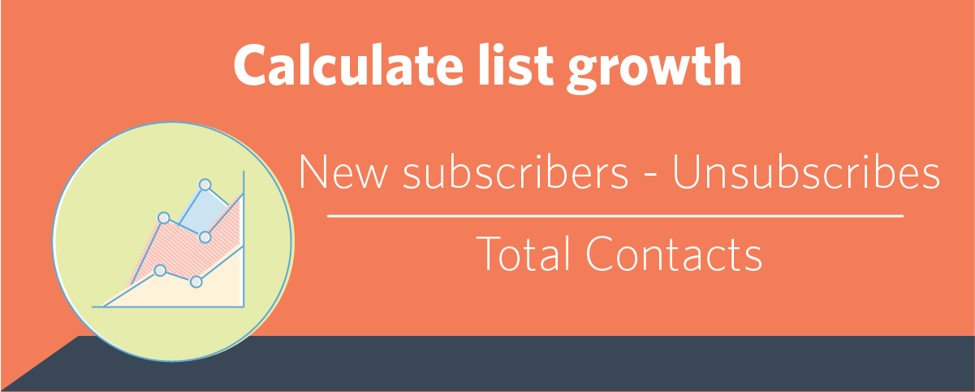
Over time, you’ll be able to test different offers and sign-up methods and then use this growth rate to compare your results.
2. Growth by source
Once you know your overall growth rate, it’s time to track where contacts are signing up from.
This will give insight into why some methods or channels may get better results and you can adjust your overall strategy accordingly. Compare the results from different tools and sources you’re using. See where you’re reaching your audience and getting them to sign-up.
With Constant Contact, it’s easy to track from the “Contact Growth” page. This page can be used to calculate your list growth rate and see the sources where contacts are signing up from.
If you find a lower amount of contacts are signing up from a specific source, you may consider focusing efforts on more effective channels, changing the sign-up details, or even adjusting the offer you use to entice people to subscribe.
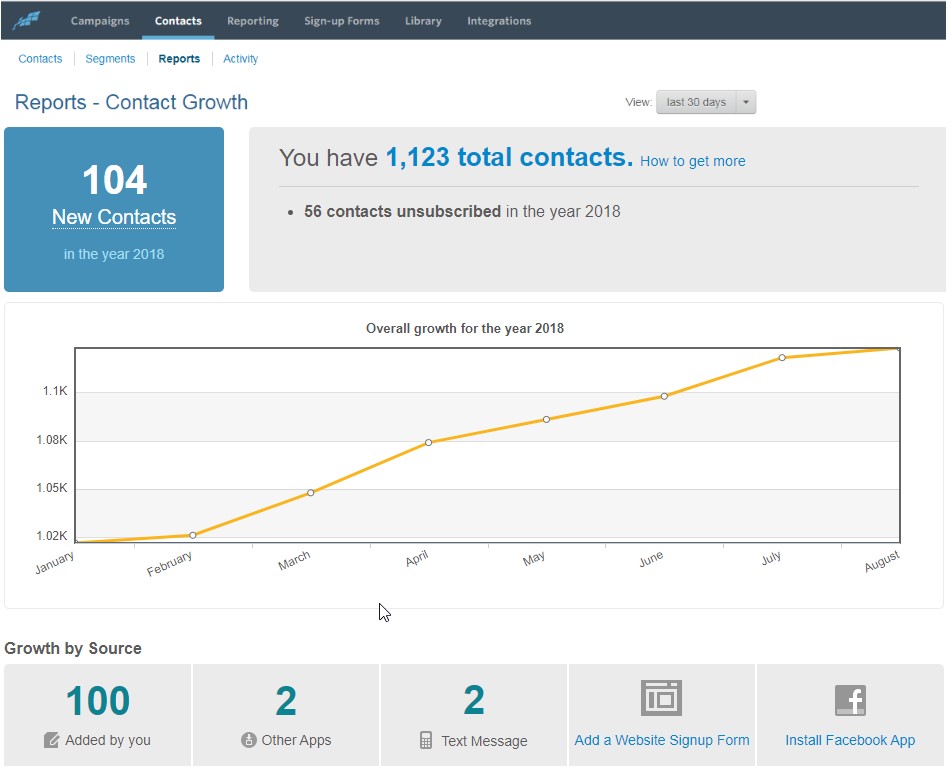
3. Contact quality
Both of the aforementioned methods are great, however, you also want to ensure that your email contacts are valuable to your business.
Focus on quality vs. quantity of new contacts. Make sure they are engaging with your business and your emails.
Take a look at the following email reports to gauge the quality of your new subscribers:
Email engagement
From your email reporting dashboard you can take a look at your open and click rates. Ideally, you want these rates to remain steady or improve as you grow your list.
Keep in mind, these rates can be affected by other factors, so be sure you’re utilizing the following metrics as well.
Bounces
Bounces can happen for a variety of reasons, and when you’re growing your list, you want to ensure the contacts who are signing up are valid and able to receive your emails.
The bounce report will show you which addresses bounced and why they weren’t delivered.
Email addresses often bounce due to a typo. If possible, you can reach out to the contact through another method to update the address. When you are unable to correct the email address, remove the bounce to keep your list clean.
If you find that you receive a high amount of bounces, you may consider adding a confirmed opt-in step for new contacts.
Unsubscribes
Due to anti-spam policies, all commercial emails are required to have an unsubscribe option.
In the Unsubscribe report, you’ll be able to see who has unsubscribed and the reasons why. Take a look at the reasons so you can adjust your list growth and email marketing efforts.
Spam complaint
While you hate to see contacts unsubscribe, you definitely don’t want them to hit that Spam or junk button.
Contacts typically hit the Spam button when they feel mislead or even if they simply want to unsubscribe.
If you find that you’re losing more contacts than gaining, take a look at your sign-up methods. While you might offer something enticing at sign-up, it’s important that contacts know what they’ll be getting after the initial interaction. Be sure to set their expectations from the get-go and that they understand the value of your communications.
Analyze your growth!
If you’re not analyzing list growth, you’ll never know where you can improve.
Use these three ways to measure your own success. You’ll be able to ensure you’re building a quality email list that grows your business.
These are the experiences of nonprofit organizations. Their daily mission: to better the world. To seek out new supporters and those in need. To boldly help where no organization has helped before!
Nonprofit communicators have plumbed social media’s depths for years in attempts to grow their organizations’ audiences and volunteers, increase donations, and even spread their missions. Despite this everyday familiarity with social media, we frequently hear from nonprofit communicators who say that they don’t know if their social media efforts are fruitful. This begs the question:
What does social media success look like?
Drum roll please …
It depends on your goals.
Ba-dum-tsk.
Super helpful, right? Don’t click away just yet! We’re diving into common nonprofit goals, the social media tactics that support them, and most importantly — quantifying success.
Did you know? You don’t need to be on every social media platform. Invest your time on the platforms where your audience is. Today, our focus is on Facebook. With more than 2.23 billion active monthly users, it’s a good idea to have a presence here.
Goal #1: Fundraising and donations
Without the public’s generosity, most nonprofits would struggle to stay afloat. It’s imperative that you establish a relationship with prospective donors and nurture your relationships with current donors.
Here’s what you should keep in mind:
- Simple is best.
- Be specific. People like to know where their money is going and exactly how it will be used.
Facebook is adding tools to allow nonprofits to collect donations and fundraise directly on Facebook. This means less bouncing back-and-forth between websites. A good rule to keep in mind is this: the greater the number of clicks, the greater the risk of losing your donor’s interest and altruism — attention spans aren’t what they used to be. Fundraising shouldn’t entail jumping through hoops, but should be an easy and seamless experience.
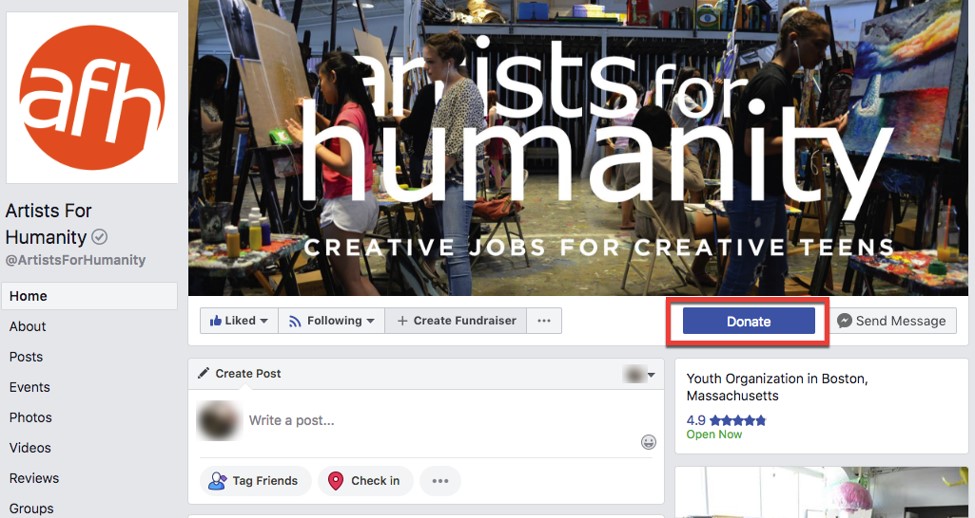
How will you know it’s working?
Now, we’re sure that you’re already tracking your donations … right? After setting up your Facebook page with the Donate button or integrating your donation software, look for changes in donation activity. Facebook offers downloadable donation reports so you can easily discern whether or not your fundraising appeals are effective.
New to Constant Contact? You can try it out with a free 60-day trial.
Goal #2: Grow your volunteer base
Nonprofit organizations run a tight ship, but there’s always room for a couple of extra bodies to help things go smoothly. Why should someone volunteer their time with your organization instead of another? It’s your job to identify that reason, and once you have, use it to attract volunteers. It’s your differentiator.
What kind of content is engaging on Facebook?
- Statistics
- Multimedia content like videos and GIFs
- Direct questions
- Lead Ads
If you post natively to Facebook, meaning you are on Facebook and creating your posts there, then you must remember to include links to your volunteer opportunities. Due to the platform’s algorithm, it can be difficult to ensure that the right people are seeing these posts. Avoid this issue by using Lead Ads. Lead Ads target your desired audience, making sure your appeal is seen by the philanthropic types out there.
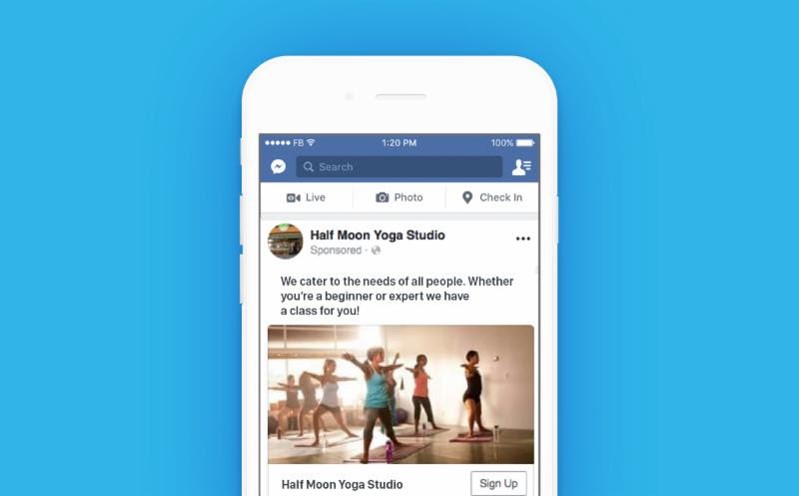
How will you know it’s working?
Much like with donations, we’re sure you’re tracking your volunteers, right? Or else how could you thank them and thereby build your relationship and increase the likelihood they’ll volunteer again? Track the number of volunteers your organization has before and after taking to social media. Set aside a few minutes each week to review your different posts. Facebook offers measurement and tracking tools, so gauging the efficacy of your posts is a breeze. Common social media measurements, as defined by Facebook, are
- Reach: How many people see your posts
- Engagement: How many people like, comment on, share or view your posts and videos
- Conversion: How many people take an action, such as share, sign up, visit your website, attend an event or donate
Are more people engaging with posts that have videos or are they responding more to your direct questions? Use these insights to tweak your strategy, and right the ship, moving forward.
Goal #3: Build awareness and engage with your donors
You spent time on an eye-catching lead ad and it paid off. Your organization has ushered its newest volunteers through the doors — when they walk out at the end of the day, what’s going to bring them back?
Two things: Your relationship and your story.
Need some tips?
- Share regularly
- Post your email marketing campaigns to your social platforms
- Add events to your Facebook page
- Multimedia posts like photos and videos perform well
- Use clear call-to-actions so your audience understands what they should do next
Then, challenge yourself to take the next step. Make things even more personal by using Messenger. Send a message to the people who are most active on your page, and respond to messages you receive in a timely manner.
How will you know it’s working?
Facebook offers a handy tool called “Page Insights.” Page Insights measures how people interact with your page so you can track your performance. These insights should influence and, ultimately, perfect your messaging which directly affects your relationship with your audience.
Measure up
Remember, success on social media, including Facebook, isn’t one-size-fits-all for nonprofits. Your posts should have a clear message and call-to-action so your audience understands what you’re asking of them. If they don’t, they can’t help you. If your posts aren’t garnering the response you hoped for right away, don’t fret! Iterate, iterate, iterate. Finesse your posts and messaging until you find what works for your organization, and always let your data be your guide. You can also explore email marketing metrics that are great for nonprofits to track!
New to Constant Contact? You can try it out with a free 60-day trial.
Want to know how to get customers to open your emails? It’s actually easier than you might think.
Email marketing works because it allows you to reach customers (and potential customers) in the place they go every day — the inbox. But once you get to the inbox, how do you make sure your emails actually get opened?
Luckily, improving your email opens doesn’t require a lot of heavy lifting.
With a few simple tweaks, you could be on your way to increased email open rates and more opportunities for your business.
In this article, we’ll fill you in on the latest developments in email open rates and give you five simple strategies you can use to get more people to open your emails.
- A quick note on increasing email open rates
- 8 ways to increase email opens from your customers
- 1. Invest in your subject line
- 2. Fix your “from name” and “from email address”
- 3. Find the best time to send (and be consistent)
- 4. Get to know your audience
- 5. Revisit your sign-up process
- 6. Segment your email list
- 7. Make your readers feel personally invested
- 8. Keep your contact list clean and up-to-date
- What’s one thing you could improve in your next email campaign?
A quick note on increasing email open rates
Email open rate (the percentage of people who open your emails) has long been a favored metric of email marketers, but things are changing. In September of 2021, Apple’s Mail Privacy Protection feature started to make it more difficult to measure the number of people who open your emails.
Previously, increasing email open rates was something many people set as a key goal in their email marketing. Now that open rates have become unreliable, there are other email marketing metrics you should focus on — ones that map more directly to your business goals.
That said, even though your ultimate goal isn’t simply getting more customers to open your emails, it’s still important that they open your emails. After all, how will they take a valuable action — like making a purchase — if they haven’t even seen your email? The only difference now is that rather than thinking about how to increase your email open rate, you’ll want to simply focus on how to make your email look interesting, valuable, and trustworthy enough to get more people to open it.
That’s what we’ll focus on in this article. So without further ado, here are five simple ways that you can get more customers to open your emails.
8 ways to increase email opens from your customers
While there are a ton of factors that determine how likely your email is to arrive in your customers’ inbox and motivate them to open, we’ll just focus on the five easiest and most important ones here. Make sure you’re thinking about all five things below with every email you send to maximize the number of customers that open your emails.
1. Invest in your subject line
Your email subject line is one of the most important lines of your entire email. Similar to an article headline or the tagline of an ad, your subject line is meant to draw people in and get them interested in what you have to offer.
Generic subject lines like “April Newsletter” or “News from [Your Business]” probably aren’t going to cut it.
Invest some extra time in your subject line before hitting send. Here are 5 ideas to help you get started:
- The question: Using a question in your subject line is a great way to make a more personal connection with the people viewing your emails.
- The command: Sometimes it pays off to be more direct with your audience as a way to get them to take action.
- The teaser: Believe it or not, people love cliffhangers. And if crafted correctly, the teaser tactic will pique interest and entice subscribers to read on.
- The list: Lists make it easier for people to consume the information you’re sending out. They also give you the chance to demonstrate your points in a more compelling way.
- The announcement: Subject lines don’t have to be complicated, especially if the goal of your email is to announce something new. Be straightforward about what your email is about.
Brand your subject lines when appropriate
While you may not always have room to inject your brand name into your subject line (the most effective subject lines are between five to seven words or 30 characters or less), it might be worth trying if you think people are having trouble recognizing your emails.
Here are a few simple ways to do it:
- [Patty’s Bakery] Pumpkin Muffins are Back!
- Pumpkin Muffins are Back at Patty’s Bakery!
- Patty’s Pumpkin Muffins are Back at the Bakery!
2. Fix your “from name” and “from email address”
Do you know what you used as the “from name” in your last email campaign? What about the “from email address”?
The from fields let readers know who an email is coming from. If you’re not thinking carefully about the information you put into these fields, you could be making it difficult for people to recognize your email when it lands in their inbox.
People are skeptical of emails when they don’t know the sender; they could be less likely to open and more likely mark your email as spam.
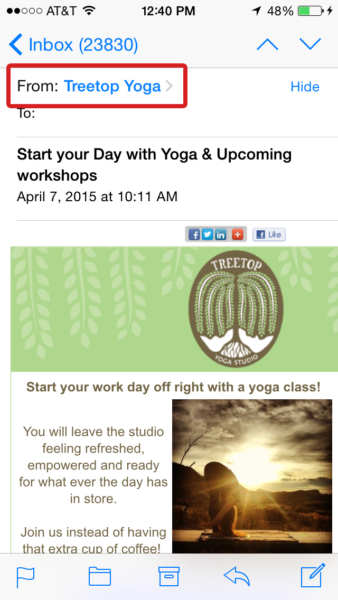
Use a familiar from name and from email address that represents your business. If possible use an email address with your business’s name in it, rather than a personal email.
Tip: Here’s how to customize your email header and footer within your Constant Contact account.
Choosing the right “From Name”
The easiest way to decide what your “From Name” should be is to answer the following question: “How will people quickly and easily recognize my business or organization?”
For some, it will be the name of your brand. For example, if Patty Smith owns a bakery with a strong local following, she should opt for Patty’s Bakery.
But if Patty is better known by her clients for her individual specialty cake services, she may want to use Patty Smith so that her clients will know it’s coming from her.
Choosing the right “From Email Address”
The email address you decided to use when you first set up your email marketing account may not be the same email address that you want to use today.
While it may seem like a small detail, for 68 percent of consumers, familiarity with the person sending the email is the top reason why they decide to open.
If you’re still using a personal email address (patty@yahoo.com) instead of your branded business email (pattysmith@pattysbakery.com), you could be missing out on another way to make your emails instantly recognizable.
3. Find the best time to send (and be consistent)
There are certain times of days when your readers are more likely to open and read your emails.
One of the easiest ways to find the best time to send is to segment your list into 2-3 equally sized groups and send the same copy of your email during different times of the day (morning, afternoon, and evening). Try this test for a few different mailings and keep track of which version gets the most engagement.
This will take a little extra time, but over the course of a few weeks, you should have a strong indication of when your readers are most likely to open.
To help you determine the best day/time to send, we analyzed a collection of Constant Contact customer mailings. You can use this chart to identify a good time to send, based on the results of others in your industry.
Not sure how to measure your email’s engagement? Check out our article on email marketing metrics that go beyond just opens and clicks.
4. Get to know your audience
You may know and understand the needs of your customers, but how much do you really know about the people on your email list?
Do you know what topics they’re interested in? Do you understand why they joined your email list? Do you have a good understanding of what questions they’re asking and how you can help address them?
Understanding your email audience is critical to getting the results you want from your email campaigns. When you learn more about your list, you can start to target your contacts with more relevant information.
Here are three ideas to help you do it:
- Survey: Send a short 1-3 question online survey to find out what topics your readers are interested in learning more about.
- Poll: Ask readers to take a quick, one question poll. You can add a poll right within your Constant Contact account.
- Reports: Use your click reports to see which links are getting the most clicks.
- In-person: You’re interacting with customers every day. Get in the habit of writing down customer questions/feedback so that you can refer back to it when you’re stuck for email ideas.
5. Revisit your sign-up process
Successful open rates start the moment someone joins your email list. It’s your responsibility to make sure they understand what they’re signing up for, and then follow through with the expectations you have set.
Take a look at your email list sign-up form. Make sure you’re answering the following questions:
- What is the value of signing up?
- What can they expect to receive?
- How often will they hear from you?
In addition to your sign-up form, take a look at all of the ways you’re adding people to your email list.
Are you getting permission before adding new contacts to your list? You’ll get a much better response rate when people opt-in to join your list. You’ll also avoid possible spam complaints that could keep you from reaching the people on your list.
6. Segment your email list
Segmenting your email list based on audience interest and behavior is one of the most effective ways to increase your opens.
A Constant Contact study found that campaigns sent to 35 subscribers or less, suggesting more personalized content, saw incredible open rates at an average of 55 percent.
Meanwhile, campaigns sent to more than 7,500 subscribers, suggesting low personalization, averaged about a 14 percent open rate.
If you’re still working with one large email list, think about the ways you can reach out to smaller more targeted groups. Are there ways you can organize your contacts based on their location, interest, or purchasing behavior?
7. Make your readers feel personally invested
Good news for nonprofits! Our email data shows that nonprofits generally enjoy higher open rates than their business-to-consumer (B2C) and business-to-business (B2B) counterparts.
Taking a closer look at specific industries, religious organizations and medical services receive over a 30 percent open rate, while product and service businesses, as well as consultancies, see lower results on average.
This speaks to the level of investment email subscribers feel with associations they are passionate about, and offers valuable opportunities for other industries to think about how they can further their connection with subscribers.
Think about how you can make your subscribers feel invested in your business by offering something of value. We recommend using an 80/20 rule, where 80 percent of your content offers value to your subscribers and 20 percent is promotional content. If you’re unsure what your specific audience will find useful, send out an online survey to get their input.
8. Keep your contact list clean and up-to-date
How often are you sorting through your contacts to check for addresses with ongoing issues? Have you ever sent out an “update profile form” to ensure you’re reaching subscribers at their most up-to-date address?
Spend some time cleaning your email list and look for opportunities to resolve any issues with addresses that may be out of date.
What’s one thing you could improve in your next email campaign?
When it comes to email open rates, small improvements can make a big difference.
This is especially important as more email clients include tabs that file your emails as “promotions” alongside other companies your subscriber has signed up to hear from. Your emails will be competing directly with other brand updates and promotions, so it’s crucial that you’re making your emails recognizable and communicating why people should open them..
The best way to stand out is to make sure the people who already know, like, and trust your business can recognize you right away!
Wondering what SEO means and how it can help your business?
Worried you don’t have the skills or budget needed to get started?
SEO is affordable and effective, allowing you to reach new customers and increase sales.
Let’s dig deeper into SEO and how it can benefit your business.
What is SEO?
SEO, or Search Engine Optimization, means setting up your website and content to show up through online search results.
While many marketing tactics rely on you reaching out to your audience, SEO gives you the power to reach people when they are actively searching out information related to your products and services.
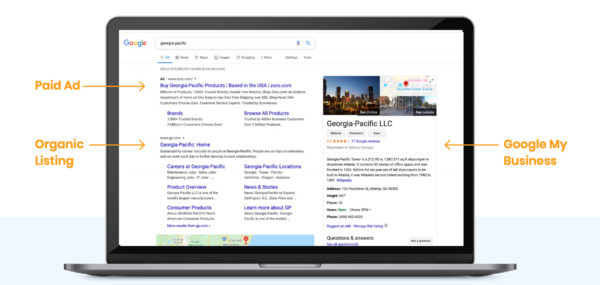
New to Constant Contact? You can try it out with a free 60-day trial.
Why is SEO so important?
If you don’t optimize your website for search engines, you risk losing potential customers to your competitors because their websites appear higher in search engine results than yours.
Think of how many times you turn to Google each day to find out which local bakeries have gluten free options or where you can get new sandals at a good price.
When someone searches for information that relates to the products and services you offer, you want to show up.
And ideally, you want to show up prominently. Research shows that 60 percent of traffic from Google searches go to websites that appear in the first three search results.
How do search engines determine where your business ranks?
Search engines use algorithms to help provide people with relevant information.
To make sure your website appears on Page 1, rather than 27, you need to focus on building authority on key topics related to your business.
Your website’s authority is determined through onsite and offsite factors.
- Onsite, search engines give higher rankings to websites that regularly publish fresh content on a specific topic. If you own a real estate agency, for example, publishing regular blog posts on home buying tips would start establishing your online authority.
- Offsite, search engines like to see that websites other than your own are linking back to your webpages. When other websites link to your content or people share your content on social media, you have a better chance of being listed prominently in search results.
How can you get started with SEO?
Influencing search engines takes time, but it pays off when you start reaching a relevant audience. If you’re just starting out, it’s best to get really specific with your focus.
Rather than writing about general home buying tips, publish content on your website that answers specific questions related to your audience.
Going back to the real estate example, things like: When is the best time to buy a home in New England? Or What is the Boston housing market forecast in 2019?
And once you start writing content, start establishing some early authority by promoting it in your email newsletter and on your social media channels.
Ready to start using SEO for your business?
If you still feel like SEO is just another confusing marketing algorithm, that’s ok.
We have a library full of helpful SEO best practices that will help you turn your website into a trusted resource that benefits your business.
If someone asked you how email marketing is helping your business, what would you say?
Chances are you wear a lot of hats at your small business or nonprofit and maybe numbers aren’t your strong suit.
You’d much rather focus on connecting with people in person to sell more of your products and services — or raise awareness for your nonprofit. But with a growing importance around data-driven marketing, being able to analyze your email marketing data is crucial.
How can you be sure that email marketing is worth your time?
Let’s take some of the dread and mystery out of measuring the impact of your email marketing, so you can be confident your emails are helping you achieve your business goals.
Use the Triple-A Approach to Email Measurement
1. Analyze
To really be in control of your marketing, it’s crucial that you know how to interpret the results of your email campaigns.
Email marketing tools like Constant Contact provide easy-to-read reports and email metrics that help you track your marketing success in real-time.
Start by taking a look at the open rates and click-through rates of your latest email campaigns. Then, compare your results with averages in your industry.
Constant Contact’s Industry Average Chart makes it easy for you to see how your campaigns stack up in relation to others in your industry.
And you might find it encouraging to know that if you’re currently getting at or above a 17 percent open rate and a nine percent click-through rate, you’re in good shape across the board! For any industry, that’s a positive level of engagement.
Now that you have a good benchmark to start with, it’s time to go beyond opens and clicks and see how your emails are impacting your bottom line.
2. Assess
Your marketing campaigns must support your business goals; otherwise, why go through the trouble?
We’ve created worksheets to help you keep track of email marketing metrics and business goals so that you always have a clear picture of how your marketing efforts are working to support your business.
We have two different worksheets in our 5-Step Approach to Successful Email Marketing guide.
- If you’re sending a sales email, download the guide, then print and use this worksheet:
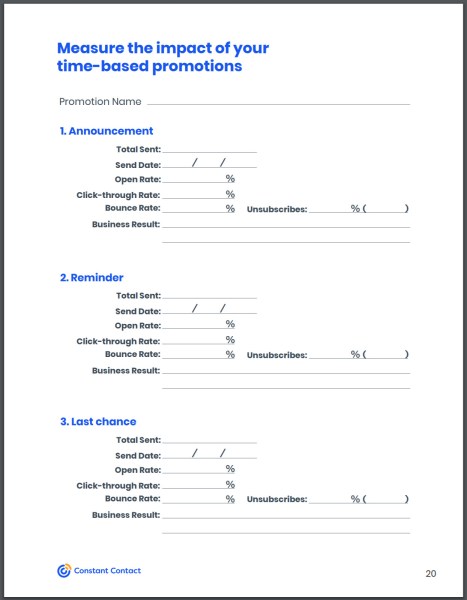
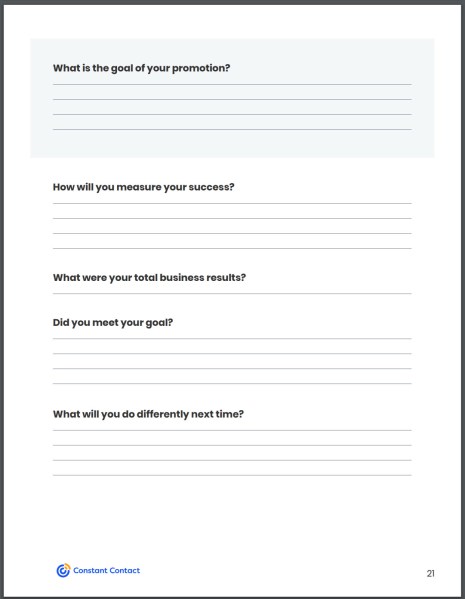
- Sending a general newsletter? Download the guide, then print and use this worksheet:
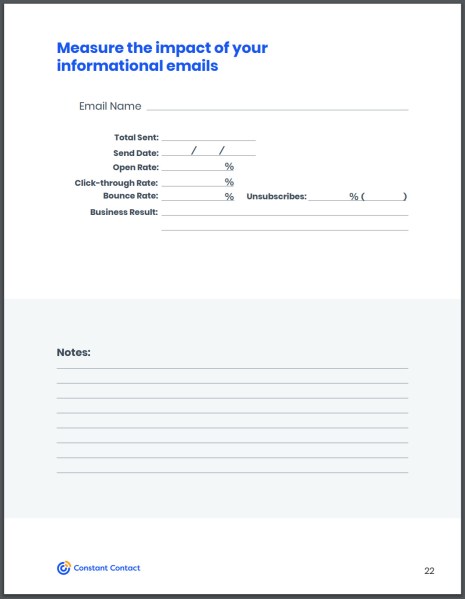
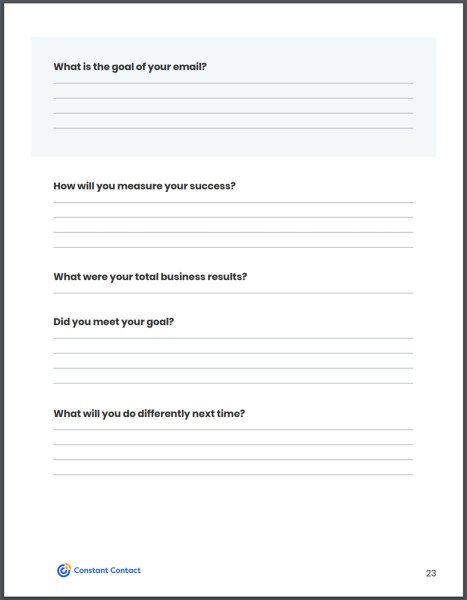
Before you even send an email campaign, start filling out the worksheets by answering two important questions: What is the goal of your email? And How will you measure your success?
To identify your goal, think about what it is that you’re hoping the campaign will achieve. Are you hoping to gather more registrants for a fundraising event? Do you want to sell 20 percent more items than last year? Are you looking to get three new consultations booked?
Whatever your goal is, the more specific you can be the better. That way you’ll know in just a glance if you hit the mark or not.
After you’ve sent your email, visit your email reports a couple days later and fill out your worksheets with the results.
Here are some key metrics to focus on:
Total Sent: the total number of contacts you sent your email to
Send Date: the date an email was sent to subscribers
Open rate: the percentage of subscribers who opened your emails
Click-through rate: the percentage of subscribers who opened your email and clicked on links within your email
Bounce rate: the percentage of emails that didn’t make it to the intended recipient
Unsubscribe/Opt-out rate: an unsubscribe or ‘opt-out ‘occurs when one of your contacts no longer wants to receive your emails and unsubscribes from your list
Tip: You can require that subscribers provide a reason for opting out from your emails.
3. Adjust
The final step is where the marketing magic happens.
Using the stats you filled out on your worksheets, answer the questions:
What were your total business results?
For a non-promotional email, this should be pretty straight-forward. For a time-based promotional email, compile your results to get the total business result.
Did you meet your goal?
That should be a simple yes or no answer based on the goal you set at the beginning.
Now, for the fun part:
Once you have figured out how an email performed and how it helped you reach your goals, adjust your strategy to optimize your marketing.
Let’s say you’re reviewing your reports for an email and discover that you had a high open rate, but a low click-through rate. This means that people were opening your email, but weren’t engaging with the links that were offered in the email.
To improve that click-through rate in your next mailing, here’s what to do next:
- Review your calls to action in your email. Consider the wording of your call to action — is it clear and intriguing? Is it telling people exactly the action they should take and why it matters to them?
- Create more white space so the email doesn’t feel overwhelming. If your email contains multiple sections, break up different topics so readers can choose what they want to read. You may also want to try breaking up each topic into separate emails to send shorter emails more frequently.
- Think about how much content is in your email. Stick to a picture, a paragraph, and a strong call-to-action that’s easy to find and click. If you have too many calls-to-action (or none at all), readers will not know what you want them to do.
Let’s look at a different scenario:
What should you do if you had a low open rate and a high click through rate?
This tells you that although not many people opened your email, the ones who did were very interested in your content.
Here’s what you can do to get more people to open your emails so they too can see your great links and content:
- Find your best time to send – Are you sending at the times and days that the majority of your subscribers are likely to read your email? Here’s how to find the best time for your business.
- Try different subject lines. Make a copy of your sent email and try resending your email with a better subject line. Don’t resend to your whole list; only send to the contacts in the Did Not Open list of your email. Then, you’ll have two separate reports to compare with the Campaign Comparison Tool to see which had a better open rate.
- Make sure your emails are relevant to your audience. Keep track of topics that are popular for your audience. Survey them with a poll to nail down what they want to read.
This chart will help guide you along when it comes to adjusting your marketing strategy to continue to improve your marketing and reach your business goals.
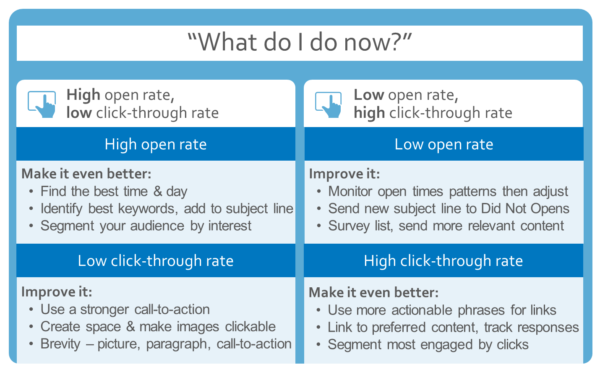
Be more confident in your email marketing results
Measuring your email marketing is not everyone’s favorite thing to do — but knowing what’s working and what isn’t will save you time, effort, and money in the long run.
And that’s certainly something to get excited about.

